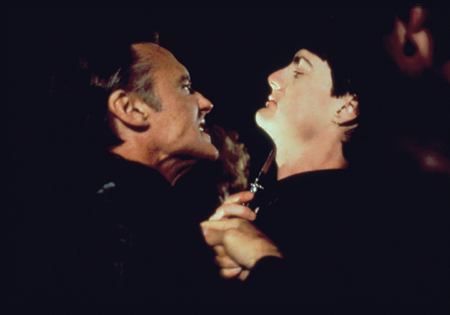
1986
Blue Velvet
DIR. DAVID LYNCH

© DE LAURENTIIS ENTERTAINMENT GROUP/EVERETT
“The Blue Lady,” Dorothy Vallens (Isabella Rossellini), in David Lynch’s visionary Blue Velvet.
One of the greatest American films of the 1980s—if not of all time—kicks into gear when college student Jeffrey Beaumont (Kyle MacLachlan) finds a severed ear in a field in the fictitious town of Lumberton, North Carolina. “It had to be an ear because it’s an opening,” writer-director David Lynch has said of his masterpiece, Blue Velvet. “An ear is wide and, as it narrows, you can go down into it. And it goes somewhere vast.”
When Jeffrey tries to solve the auricular mystery by breaking into the apartment of saloon singer Dorothy Vallens (Isabella Rossellini), he sparks the wrath of psychosexual sadist Frank Booth (a blisteringly brilliant Dennis Hopper). “I had always wanted to sneak into a girl’s room to watch her at night,” Lynch has said of the film’s inspiration. “Maybe, at one point or another, I would see something that would be a clue to a murder mystery.”
A defining neo noir, Blue Velvet clearly has its roots in classic noir, and owes a debt to both Rear Window and Sunset Boulevard, among others. “Rear Window is one of my favorite movies,” the director has said, “because it’s got such a mood, and even though I know exactly what happens next, I enjoy to be in that room and feel that time. It’s almost like I could smell it.”
Though often erratic, Lynch’s subsequent work continued to reflect his noir inspirations, with Blue Velvet becoming the template for his 1990s cult TV series, Twin Peaks. And Sunset Boulevard was a prominent influence on 2001’s Mulholland Drive, the director’s dark valentine to Hollywood. But Lynch never equaled the combination of perversion and exhilaration that defined Blue Velvet. As of 2016, he hadn’t directed a feature film in a decade.
Thirty years after Blue Velvet’s release, it’s not easy to understand just how raw and shocking its surreal sexuality and violence were at the time. The singer Roy Orbison—whose song “In Dreams” is prominently featured in the film—has said that viewing it reminded him of seeing Elvis Presley for the first time in 1955. “He came out and spat out a piece of gum,” the singer said. “I can’t overemphasize how shocking he looked and seemed that night . . . It affected me exactly the same way as when I first saw that David Lynch film. I just didn’t know what to make of it. There was just no reference point in the culture to compare it.”

© DE LAURENTIIS ENTERTAINMENT GROUP, COURTESY PHOTOFEST
Dennis Hopper as Frank Booth menaces Kyle MacLachlan as Jeffrey Beaumont.

© DE LAURENTIIS ENTERTAINMENT GROUP/EVERETT
Is she a murderess, a victim, or both? The haunted and haunting Vallens peers from her apartment at Jeffrey, who is pretending to be an exterminator in an attempt to solve a murder mystery. “I don’t know if you’re a detective or a pervert,” says Laura Dern as Sandy Williams. In a film defined by moral ambiguity, he’s a little bit of both.